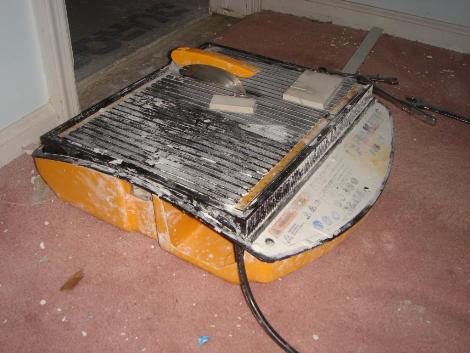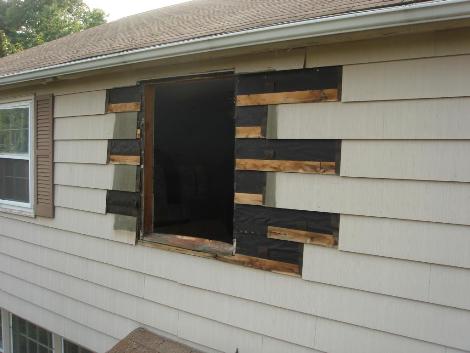
When I started planning our bathroom remodel, I began looking into different methods for cutting tile. There are a slew of choices, Tile snappers, wet saws, jig saws with carbide blades, or nippers. I looked at Lowes and saw that they had some decent looking saws, and picked out a mid-range one, the Felker FTS-50. Since I was only doing a small bathroom I figured this would be just what I needed. I’d never used a wet saw, so I tried it out and it seemed to cut well and besides for being incredibly loud, I was pretty happy. The saw came with a crappy plastic fence, a little plastic thing that was meant to help guide the tiles if you cut them at an angle. I tried to use these at first, but found them to be causing more problems than they solved, and ended up just drawing a line on the tile and cutting them free hand.
Cutting the tiles in this manner worked well, however after awhile I noticed the cuts where chipping alot. I assumed that since I was using a porcelain tile, the blade had worn out. I figured the blade that came with the saw wasn’t of the highest quality, and that I could just buy a replacement blade and all would be well. However this is where things go south. I went to Lowes, and found, that while they have 4″, 4.5″ and 7″ Diamond blades, they don’t have a 5″ blade. I thought about getting a smaller blade, but if the blade wasn’t big enough then it wouldn’t touch the water. Well I assumed they were just out of stock, so figuring you can buy anything online, I turned to the web. After a ton of searching I realized that 5″ tile saws are not very common, in fact this Felker may be the only one. Therefore getting a blade was not easy. I asked at one store for a porcelain blade and was told that the FTS-50 was not cut out for porcelain tile, and that the motor would surely burn up if I tried. Well a bit late for that, wish someone had told me that before I bought it.
At this point I sent an e-mail to Felker, asking where I could get a replacement, and was told to check local tile stores. I replied saying that I had, and they didn’t carry 5″ blades, but never heard anything back. After alot of searching I finally managed to get a new blade from the nice folks at PremiumBlade.com . It wasn’t anything fancy, but it was pretty cheap, and I did notice that it had alot more diamonds in it than the original. I quickly installed this and made a few trial cuts. To my surprise, the tile still chipped and the cuts weren’t clean. As I was playing around with it, trying to figure out why, I noticed that the blade seemed to wobble. It was hard to tell when it was moving, but easy to see as the blade came to a stop. After re-installing the blade a few times, a came to the conclusion that the shaft was actually bent. At this point I went back and looked at some of the tiles I cut earlier, and noticed they none of the cuts looked very smooth, and they all had alot of chipping. So I assume that I just never noticed it before. So at this point, I’m going to just have to live with the poor quality of the saw. Its to late at this point to return it, and I certainly don’t want to waste another $100 on a better saw.
If anyone else is thinking of buying a Wet Saw, I would highly recommend not getting the FTS-50. Felker Saws have a good reputation, however regardless of how good the saw is, getting one that you can’t get a replacement blade for is just silly. In fact, I’m amazed that Lowes even sells this saw.
